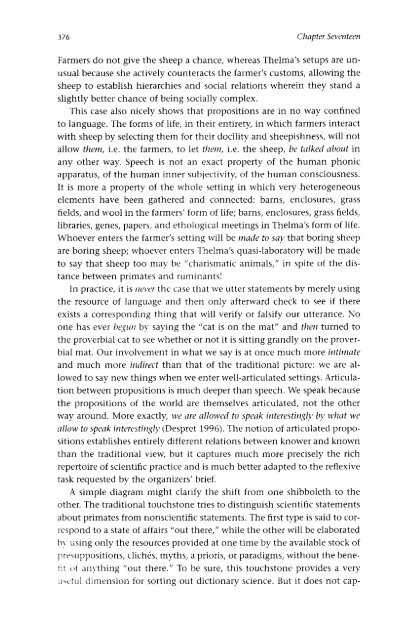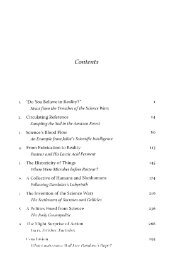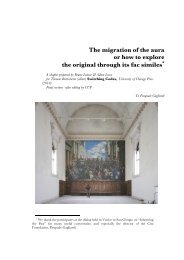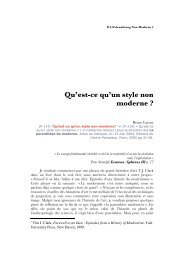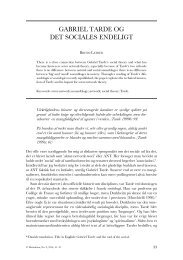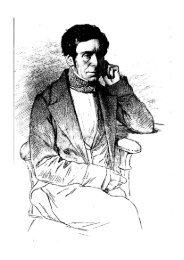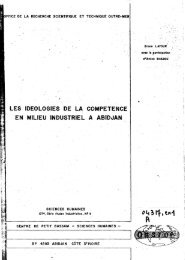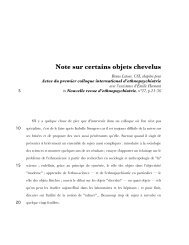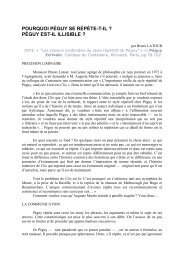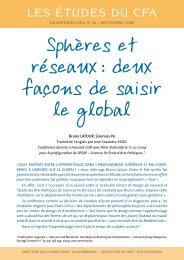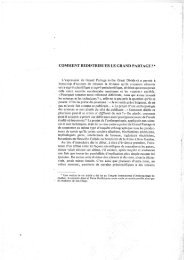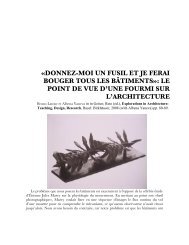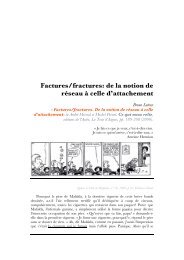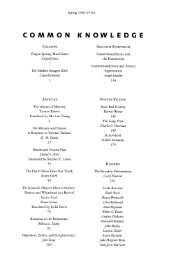A Well-Articulated Primatology - Bruno Latour
A Well-Articulated Primatology - Bruno Latour
A Well-Articulated Primatology - Bruno Latour
Create successful ePaper yourself
Turn your PDF publications into a flip-book with our unique Google optimized e-Paper software.
376 Cha7ter Seventeen<br />
Farmers do not give the sheep a chance, whereas Thelma's setups are unusual<br />
because she actively counteracts the farmer's customs, allowing the<br />
sheep to establish hierarchies and social relations wherein they stand a<br />
slightly better chance of being socially complex.<br />
This case also nicely shows that propositions are in no way confined<br />
to language. The forms of life, in their entirety, in which farmers interact<br />
with sheep by selecting thern for their docility and sheepishness, will not<br />
allow them, i.e. the farmers, to let tlrcm, i.e. the sheep, Ûe tolked about in<br />
any other r,r'ay. Speech is not an exact propert,v of the human phonic<br />
apparatus, of the human inner subjectivity, of the human consciousness.<br />
It is more a property of the whole setting in which very heterogeneous<br />
elements have been gathered and connected: barns, enclosures, grass<br />
flelds, and r.t'ool in the farmers' fonn of life; barns, enclosures, grass fields,<br />
libraries, genes, papers, and ethological rneetings in Thelma's form of life.<br />
Whoever enters the farmer's setting lvill be tnade to sdl that boring sheep<br />
are boring sheep; whoever enters Thelma's quasi-laboratory will be made<br />
to say that sheep too ntav be "charismatic animals," in spite of the distance<br />
between primates and runrinantsl<br />
In practice, it is rrelt'r.thc case that ne utter statements by n-rerely using<br />
the resource of language and then only afterward check to see if there<br />
exists a correspondir-rg thing that will verify or falsif.v our utterance. No<br />
one has ever begurr bv sal,ing the "cat is on the mat" and thert turned to<br />
the proverbial cat to see whether or not it is sitting grar-rdly on the proverbial<br />
mat. Our involvement in what we say is at once much more intinnte<br />
and much morc indircct than that of the traditional picture: we are allowed<br />
to say new things when we enter well-articulated settings. Articulation<br />
between propositions is much deeper than speech. We speak because<br />
the propositions of the rn'orld are themselves articulated, not the other<br />
way around. More exactly, \r'e dre allowed to speak interestitrgh'b1'r+'hat we<br />
ollov,to speak interestirrgli'tDespret 1996). The notion of articulated propositions<br />
establishes entirely different relations between knower and known<br />
than the traditional view, but it captr.rres much rnore precisely the rich<br />
repertoire of scientific practice and is much better adapted to the reflexive<br />
task requested by the organizers' brief.<br />
A simple diagram might clarify the shift from one shibboleth to the<br />
other. The traditional touchstone tries to distinguish scientific statements<br />
about primates from rronscientific statements. The first t1,pe is said to corrcspond<br />
to a state of affairs "out there," while the other will be elaborated<br />
ll usir.rg only the resources provided at one time by the available stock of<br />
presuppositions, clichés, rnyths, a prioris, or paradigms, without the benetrt<br />
of anvthing "out there." To be sure, this touchstone provides a very<br />
Lr.tlul clinrension for sorting out dictionary science. But it does not can-


